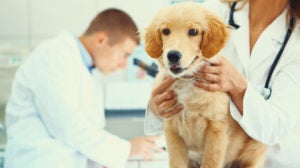
Learning Objectives
Students will learn about how the environment can affect canine health. Students will demonstrate an understanding of the importance of proper diet and exercise in dogs, as it can positively or negatively affect specific traits, such as weight.
Grade Levels
3-5
Next Generation Science Standards
3-LS3-2: Use evidence to support the explanation that traits can be influenced by the environment.
Materials Needed
AKC Article, “Dog Obesity: Why It’s Important to Manage Your Dog’s Weight”: HERE
AKC Video, “Is Your Dog in Shape”: HERE
Learn. Genetics Video, “What are Traits?”: HERE
Lined Notebook Paper
White Copy Paper, 8 X 11” (5 sheets per group)
Create Your Own Healthy Dog Book Directions: HERE
Stapler
Art Supplies (markers, crayons, stickers, etc.)
Lesson
Introduction and Guided Practice
- Begin the lesson by reviewing the vocabulary words environment and traits. Set a classroom timer for 1 minute for each word and have students write down as many words or phrases that they can think of relating to each vocabulary word. Share students’ thoughts as a class and then provide the actual definitions for each below:
environment: the surroundings or conditions in which a person, animal, or plant lives (ex. nutrition/diet, exercise, temperature, air pollution, income level, age, etc.)
traits: a characteristic that is caused by genetics and environment (ex. eye color, weight, height, hair color, etc.)
- Show students the video “What are Traits?”. Have students share one thing that they learned from the video and discuss as a class.
- Transition the discussion into talking about how dogs have traits just like humans do. Traits in dogs can be influenced or affected by the genes passed down from their parents and by the environment they live in. For example, a dog can become overweight if their owner does not give them a proper diet and enough exercise. This is all part of being a responsible dog owner.
- Engage in a brief Think-Pair-Share activity. Ask students the following question and have them think about it to themselves for one minute: How can you prevent a dog from being overweight? Pair students with a partner and have each group write down their ideas on notebook paper. Have students share their ideas with the entire class.
- Show students the AKC video with Veterinarian Dr. Andrea Tu, “Is Your Dog in Shape?” Instruct students to write down 5 facts about proper dog exercise and diet as they watch the video.
Independent Activity with a Partner
- Pair each student with a partner. Hand out copy paper to student groups (5 sheets per group). Instruct students to make a book out of the paper, by lining up all 5 sheets together evenly, and then folding across hamburger style. Demonstrate for students. Circulate and staple the edges of each group’s book.
- Hand out the AKC Article, “Dog Obesity: Why It’s Important to Manage Your Dog’s Weight”, Create Your Own Healthy Dog Book Directions, and art supplies to each group.
- Read the article together as a class and answer any questions.
- Read the book directions with students and create an example template for them to reference if necessary.
- Circulate and assist students as they complete their books with their partners.
Review and Closing
- Have students present their books to the whole class. Groups can swap their book with another group and practice partner reading.
- Display the books around the classroom.
References
Fitzgerald, Dr. Kevin. “How to Tell If Your Dog Is In Shape Or Overweight.” American Kennel Club, 23 Jun 2016, https://www.akc.org/expert-advice/health/how-to-tell-if-your-dog-is-in-shape-or-overweight1/.
Genetic Science Learning Center. “What are Traits?” Learn.Genetics. March 1, 2016. https://learn.genetics.utah.edu/content/basics/traits/.
“Why It’s Important to Manage Your Dog’s Weight.” American Kennel Club, 22 Jun 2019, https://www.akc.org/expert-advice/health/fat-dogs-and-dog-obesity/.

